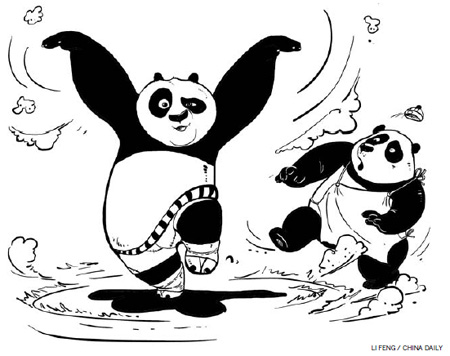Op-Ed Contributors
Debate: Chinese film
Updated: 2011-07-04 07:49
(China Daily)
Can Chinese movies take on the challenge of Hollywood productions at home, create a niche in overseas markets, triumph at international competitions and promote China's soft power?
Chen Gang
A perfect example of profit-making
Since June 15, many people have watched Beginning of the Great Revival, a film on the 10 years between the Revolution of 1911 and the founding of the Communist Party of China (CPC) in 1921. The characters in the film, including Sun Yat-sen, Chen Duxiu, Li Dazhao, Mao Zedong, Zhou Enlai, Soong Ching Ling, are familiar names for any Chinese.
So why should people pay at least 35 yuan( $5) to watch a film that portrays characters they already know well? The reason is simple. The film belongs to a genre that originated in Hollywood under the studio system in the early 1900s. The audience has always loved this genre of films, for they emphasize star appeal, encourage business, and underline the plot and fluent space-time combination.
Although certain genres of films have similar themes, plots, figures, scenes and narrative style, people still pay to watch them, because they feel a sense of security and even get satisfaction watching a movie that reflects their emotional experiences.
From The Founding of a Republic (released in 2009) to Beginning of the Great Revival, directors Han Sanping and Huang Jianxin have tried to restructure traditional mainstream movies into a certain genre that uses the operational mode of commercial blockbusters. Inherent dominant ideology, an all-star cast, and a marketized operational mode in financing, filmmaking, distribution and publicity are the three principal elements that define this genre.
Mainstream Chinese movies, especially those with important historical themes, should spread the country's dominant ideology and cultural values. By watching such films, the audience should be able not only to recall history and understand the roots and development of our culture, morals and traditions, but also meet the need to ritualize the dominant national ideology.
But earlier mainstream films expounded these aspects mechanically. A large number of figures that they portrayed lacked individuality, they simplified the appreciation of beauty and had a stereotyped narrative mode, which left the audience aesthetically fatigued. Besides, quite a number of mainstream films were failures at the box office and couldn't effectively transmit the dominant ideology and cultural values to the audience.
Beginning of the Great Revival is different from such films. It integrates the cultural heritage and social values into the plot and characters. Instead of transmitting the dominant ideology directly or forcedly to the audience, it uses a "flexible expression", which is subtly hidden in the narration, to do so. It tries to restore the inner emotions of historical figures, breaking the stereotype portrayal of the characters being "perfect" in every respect. It avoids lending ugliness artificially to the negative characters, too, and instead tries to open their complicated state of mind.
Also, the plots of Han's and Huang's two films do not simply follow history textbooks. Instead, they add more of a "human" touch to the characters. That's why in The Founding of a Republic and Beginning of the Great Revival, we see scenes like CPC leaders "celebrating" a victory, a young Mao Zedong's romantic walk in the snow with Yang Kaihui, and the self-questioning of Yuan Shikai after his dream of becoming the emperor is shattered.
In The Founding of a Republic, 172 stars formed the main cast, which was a record. A popular actor or actress reportedly appeared on the screen every 49 seconds in the film, which was a major draw for the audience. Beginning of the Great Revival continues this trend, attracting nearly 200 Chinese stars. If popular actors and actresses play the role of historical figures, the audience, especially people born in 1980s and 1990s, find it easy to associate themselves with the characters. The stars are also a guarantee of healthy box office returns.
Previous mainstream films rarely paid attention to the business aspect, and relied fully on block bookings by companies and public institutions for box office returns and passing on their message to the audience. Rarely did such filmmakers think of using innovative methods to prompt individuals to pay for a ticket to watch their films.
Beginning of the Great Revival goes beyond that; it does not rely on government investment and has charted a course of its own to earn - or lose - money. Media reports say about 40 financiers, mainly State-owned and private filmmaking companies, have invested in the film and shared the risks. The film was treated as a commercial venture right from its inception through to production, distribution and marketing.
Moreover, the use of advanced technologies such as three-dimension and multi-camera shots has made the film an exceptional gift for the audience, fulfilling their need for aesthetic appreciation.
Production and marketing executives have used the fanciest marketing tools like star promotions and event marketing for the film's distribution.
The Beginning of the Great Revival provides a reproductive paradigm for films disseminating the dominant ideology. It has proved that mainstream movies can touch the audience emotionally if they follow the principles of artistic creation and market norms.
The author is a research scholar with the Beijing Film Academy and a lecturer at the College of Humanities and Development, China Agricultural University.
Peng Kai
Balance between culture and story
Beginning of the Great Revival is creating waves at the box office as the nation celebrates the 90th anniversary of the Communist Party of China (CPC).
Perhaps the timing of the historical films release - just before the 90th anniversary of the CPC - has something to do with its success. A success it is, nevertheless.
A rumor doing the rounds suggests the film's producers "monopolized" the distribution channel using administrative power to ensure that the movie was a commercial success, which, if true, is a step backward after the marketization reform of the Chinese film industry.
Irrespective of the reasons for its success, there is no denying that Beginning of the Great Revival is a breakthrough in filmmaking. For example, directors Han Sanping and Huang Jianxin invited many young stars instead of typecast actors to play the roles of historical characters. That has helped present a more vivid image of the characters in their youth.
The directors have made some innovations in some of the story. For example, the film is perhaps the first to show a young Mao Zedong encountering his first love. The film tries to look into the minds of some notorious historical characters, too, instead of presenting them simply as villains.
Despite all this, it's very difficult for other filmmakers to copy the success formula of Beginning of the Great Revival. Simply put, too many factors have combined to make it success. Instead, a film like Kung Fu Panda 2 can teach Chinese filmmakers a lot.
Of late, Hollywood filmmakers have used many Chinese elements or Chinese actors, actress and other performers in their productions. But their films usually portray a stiff Chinese image, and use Chinese symbols and/or characters as ornaments.
The Kung Fu Panda films are an exception, for they blend Chinese elements with Hollywood narrative mores. They use pure Chinese visual and audio elements. Except for the language of the characters, Chinese traditional elements are omnipresent in the films. The Chinese elements include ink and wash paintings as the background landscape, ordinary Chinese community life in Peace Valley and Phoenix City, acrobatic fighting used in Chinese opera or dance, and even the melodious sound of the erhu in the background music.
Moreover, the movie can be regarded as world-class publicity for the pandas' hometown of Chengdu in Sichuan province. Thanks to the efforts of the local government, the filmmakers have integrated some local characteristics into the movie.
In a bid to support the reconstruction of Sichuan province after the May 2008 earthquake, the movie even uses the Qingcheng Mountain, and Sichuan-style food such as noodles and hotpot as part of the setting.
But many Chinese filmmakers see the Kung Fu Panda films as a threat. With the audience considering some foreign films native enough to be international propaganda vehicles for Chinese culture or a Chinese city, the advantage Chinese films used to enjoy seems to be disappearing gradually.
Kung Fu Panda 2 has already grossed more than $100 million at the box office, while Kung Fu Panda 1, released in 2008, has earned about $630 million worldwide, more than all the Chinese films could make that year. And Kung Fu Panda 3 is already in production, suggesting that panda and kungfu have become big money-spinners in Hollywood.
This seems ironic to many Chinese filmmakers. Some critics have even urged the Chinese people to boycott the Kung Fu Panda films, which is ridiculous in this era of globalization and will in no way help China's film industry in the long run.
For the last six years in a row, the share of domestic movies at the box office in China has been more than that of imported films.
But the success has been achieved with the help of the quota system, which allows only 20 new foreign films and some outdated movies to be screened in China in a year.
It is precisely because of the quota system that the United States moved the World Trade Organization (WTO) against China in 2007. In 2009, the WTO condemned China's policy and asked it to allow more foreign films to be screened in the country. This means that in the near future, more Hollywood movies could enter the Chinese market posing a greater challenge to domestic productions.
The question: Can Chinese movies take on the challenge of Hollywood productions at home, create a niche in overseas markets, triumph at international competitions and promote China's soft power.
Beginning of the Great Revival is not a good example in this case, because not all Chinese movies can attract as much capital and resources. And even if some of them manage to do so, the end product may not be as good as the Kung Fu Panda films in attract- ing viewers across the globe.
Traditional Chinese elements remain a competitive advantage, though. Some Chinese filmmakers used to make the best use of these elements to come up with fascinating and trend-setting films like Ang Lee's Crouching Tiger, Hidden Dragon. Period films complete with swordsman and kungfu can attract viewers across the world but that novelty factor won't last long.
Taking a leaf out of the Kung Fu Panda films, Chinese filmmakers have to strike a balance between traditional culture and narrative methods to integrate history into commerce.
The author is a research scholar with the Film Academy of Hong Kong Baptist University.


Specials

90th anniversary of the CPC
The Party has been leading the country and people to prosperity.

My China story
Foreign readers are invited to share your China stories.

Green makeover
Cleanup of Xi'an wasteland pays off for ancient city